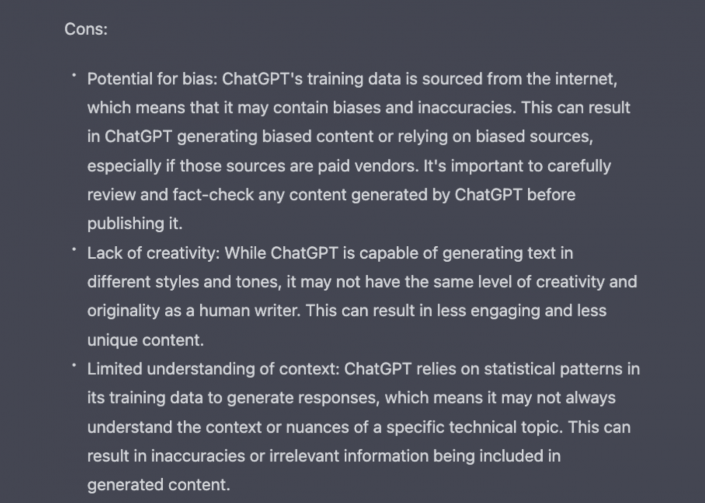The use of artificial intelligence (AI) language models like ChatGPT for content generation has attracted increasing attention in recent months, especially since the latest release and media hype surrounding its use. While these tools have the potential to save time and resources for researchers and companies alike there are also concerns around their use, particularly when it comes to maintaining editorial oversight, avoiding plagiarism, and ensuring accuracy and quality of the articles that in some cases are rife with errors highlighting the need for careful consideration and mitigation of potential risks arising from the use of these tools.
Background ChatGPT[1] is the SotA (state of the art) in natural language processing as an AI language model. Developed by OpenAI, ChatGPT is the result of years of intensive R&D, building on the work of previous language models from the company such as GPT-1 through 3. It is essentially a refined version of GPT-3.5. With GPT-4 only being announced recently [2] allowing for multimodal input such as imagery similar to its cousin DALL-E[3].
ChatGPT was designed to fill the market need for a language model that could understand and generate natural language responses to a wide range of technical topics. In this case context is king and the ability of the tool to contextualise data, while nowhere near perfect, is a step beyond current techniques from competitors. It has seen mass adaptation in recent months and gone “viral” across the technical world. However, while there are advantages to the technology that will only improve over time, it is the human element needed to structure and decode the responses that will ultimately decide how useful an aide it will be.
Pros:
As a thought experiment let’s use ChatGPT to generate a list of its own pros/cons:

Looking at each point
- Knowledgeable: While it does have access to a large volume of training data which on the surface may seem great but dig a little deeper and cracks begin to show as it can also be used as a source of misinformation and is surprisingly good at it[4].
- Saves time: The time required to capture the content and verify it for inconsistences, grammatical errors, potential bias and material that cannot be cited really downplays this.
- Versatile: One aspect of the model that is hard to play down is its ability to rephrase and rewrite vast swathes of text. But if the above two points are still at play, then re-writing garble is still garble.
Cons:
Similarly a generated set of cons:

Reviewing these points:
- Potential for bias: This is a rather serious issue underpinning much of the data taken from ChatGPT (and others). The ability for ChatGPT to discern what could potentially be a paid source of information versus a unbiased product/technology review is severally limited.
- Lack of creativity: ChatGPT as it stands reads poorly and it is obvious that it is a computer-generated piece. It can lead to less introspection on issues and topics that otherwise would evoke some thought.
- Limited understanding of context: A key point to note as this can cause major discrepancies when trying to run through ideation or combine multiple idea streams into a cohesive block of logic.
While it can be an effective tool for creating technical blogs, it’s crucial to thoroughly analyse any automatically created text for biases and mistakes. The key is to take into account the technology’s limitations in order to create material that is high-quality with a human touch.
Where is it going?
We can see language models like ChatGPT, and its rivals, being more prevalent in our everyday lives. Much akin to modern day voice assistants such as Alexa, Google assistant or Siri. The technology itself can only be improved from here and with similar tools from the likes of Microsoft, who recently announced integration with Office 365[5] giving wider access to a larger dataset can bring improvements to the tool. The issues identified above including bias, inconsistencies and credibility require careful steps to be taken to make sure it remains useful without generating ethical or privacy issues in data gathered .
Cautious of its accuracy
There have been some recent concerns raised about the use of AI language models like ChatGPT to generate content for news and media outlets like CNET. In January of 2023 it was found that errors were found in more than half of the sites AI generated content which led to the company stopping the use of their AI tool[6]. Therefore, it is important to note generated material might not be as thoroughly examined or fact-checked as material created by human writers.
Conclusion
While AI language models like ChatGPT have the potential to be valuable tools for content creation, there are important considerations to keep in mind, particularly in technical fields where accuracy, quality, and editorial oversight are critical to ensuring the reputation of research outputs. Technical writers will need to carefully evaluate the risks and benefits of using AI-generation language models like ChatGPT/Bard, and take steps to mitigate potential issues.
However, it’s important to note that ChatGPT is not a substitute for human expertise, and it will never be able to replace the insights and knowledge that come from experience and training. Instead, ChatGPT should be seen as a complementary tool that can assist with the writing process and help augment human capabilities.
Written by Ian Mills, ARVR Technical Lead, TSSG Technology Gateway, Walton Institute
[1] https://openai.com/blog/chatgpt
[2] https://openai.com/product/gpt-4
[3] https://openai.com/product/dall-e-2
[4] https://arxiv.org/pdf/2301.04246.pdf
[5] https://www.theverge.com/2023/2/10/23593980/microsoft-bing-chatgpt-ai-teams-outlook-integration
[6] https://www.theverge.com/2023/1/25/23571082/cnet-ai-written-stories-errors-corrections-red-ventures
